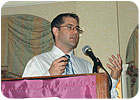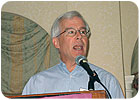
Shawn Martin, NAHB: Water conservation efforts that focus only on the fixtures will not solve the problem.
Water conservation efforts that focus only on the fixtures will not solve the problem - future efforts must look beyond the fixtures to the system as a whole, according to Shawn Martin, director, Applied Technology Division, National Association of Home Builders Research Center. This includes piping system design, greywater reuse, rainwater collection, user behavior and distributed water heating. Martin was one of the speakers at The Plumbing Manufacturers Institute’s Fall Meeting Oct. 8-11 in Washington, D.C. Following are highlights of what some of the speakers shared:
Shawn Martin, Applied Technology Division, NAHB Research Center
Although builders know about other piping distribution systems, they don’t always know when to use them. Many plumbing systems are installed without the benefit of much advanced planning or design, especially in residential.Here is part of a comparison of the attributes of three piping distribution systems - trunk and branch, remote manifold and home-run.
The trunk and branch system was rated highest for minimizing pipe used, sequential flow hot water delivery time and single fixture pressure.
The remote manifold system, like the trunk and branch system, was rated highly effective at sequential flow hot water delivery time.
The home-run system achieves the highest level of performance in minimizing fittings and joints, minimizing hot water wait time, pressure stability with the use of multiple fixtures, centralized shutoff valving and joint accessibility during installation.
There is no one system that works best in every situation. A number of considerations come into play. One system may perform better but cost more because it requires more fittings, which means more labor hours. Another system may cost less to install and be more versatile, but not be the best choice in a particular setting for other reasons.

Mahesh Cheerla, director of product development, BrassCraft, was a first-time attendee at the PMI Fall Meeting.
Water availability will remain an issue for some time to come. Population growth is expected to be concentrated in areas such as California, Arizona and New Mexico, which have the least amount of water.
In terms of user behavior, more study is needed regarding how people interact with conserving devices vs. traditional fixtures. If a person washes his hands X minutes when using a traditional faucet, will he wash longer when using a low-flow faucet? How will a person use a low-flow showerhead or a dual flush toilet vs. traditional models?
NAHB Green Home Building Guidelines were introduced last year, designed to be accessible, flexible, holistic and voluntary. The guidelines are considered usable and affordable for the mainstream homebuilder, can be customized to reflect local issues and challenges, and emphasize a systems-based and market-driven approach.

Drury Crawley, U.S. Dept. of Energy: We need to advance technology and water conservation to accomplish zero-energy buildings that are cost effective.
Drury B. Crawley, U.S. Dept. of Energy
Crawley manages the DOE’s building energy software tools research and development activities and also chairs the ASHRAE committee on sustainability and water stability.ASHRAE expects to release the second version of its Green Guide, including 29 GreenTips (sidebars with information on techniques, processes, measures or systems) before the end of the year.
The new version deals with water - collecting rainwater and dealing with wastewater. Water is becoming very important. A lot of water goes into the production of power, but it varies by location. The water evaporates or has to be re-treated.

David Sheridan of Aqua Cura: More commercial owners should consider installing submeters. They cost so little and can provide so much information.
David Sheridan, P.E., principal, Aqua Cura
Two trends will influence Green Building and have a pronounced effect on the water efficiency issue: climate change and petroleum depletion. Dryer areas will get dryer.Potable water will become more expensive and less reliable. Centralized electric power will be less reliable. The roofs of buildings will be considered as a place to gather water for drinking.
Where possible, houses will be equipped with a compost unit under one of the bathrooms.
Potable water will become too dear to use for carrying out wastewater. There will be greater interest in non-water-using urinals.

Frederick Luedke, president of Neoperl, attended the meeting with his wife, Jeanne.
The Plumbing Manufacturers Institute should weigh in on the “very high-efficiency” issue, such as maximum performance for high-efficiency toilets or showerhead and mixing valve combinations. Also, PMI should define water quality requirements for fixtures and fittings.
